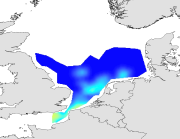Species and habitats - Clupea Harengus - Larvae - < 15mm - IBTS Annual abundance in January (2008-2011)
Simple
- Autres appellations ou acronymes
- IBTS_species_geostatA
- Date ( Publication )
- 2012-03-23T00:00:00
- Identificateur
- CHARM_CLUPHARsmall_larvae_IBTS_2008-2011
- Forme de la présentation
- Carte numérique
- Autres informations de référence
- Source CHARM Consortium
- Reconnaissance
- IFREMER
- Reconnaissance
- CHARM consortium
- Etat
- Finalisé
- Fréquence de mise à jour
- Lorsque nécessaire
- Thèmes Sextant ( Thème )
-
- /Biological Environment/Species/Fish Species of Commercial Interest
- Mots clés ( Discipline )
-
- Species data set
- CHARM
- Hareng commun
- Atlantic herring
- GEMET - INSPIRE themes, version 1.0 ( Thème )
-
- Répartition des espèces
- external.theme.gemet ( Thème )
-
- ressource halieutique
- Limitation d'utilisation
- research-only
- Contraintes d'accès
- Licence
- Autres contraintes
- Has to be cited this way in maps : "Source CHARM Consortium"
- Autres contraintes
- Has to be cited this way in bibliography : "Carpentier A, Martin CS, Vaz S (Eds.), 2009. Channel Habitat Atlas for marine Resource Management, final report / Atlas des habitats des ressources marines de la Manche orientale, rapport final (CHARM phase II). INTERREG 3a Programme, IFREMER, Boulogne-sur-mer, France. 626 pp. & CD-rom"
- Type de représentation spatiale
- Raster
- Dénominateur de l'échelle
- 2500
- Langue
- fr
- Langue
- en
- Jeu de caractères
- Utf8
- Catégorie ISO
-
- Océans
- Biote
- Environnement
- Description de l'environnement de travail
- Microsoft Windows XP ; ESRI ArcGIS 9.x
- Identifiant géographique
- Eastern English Channel
))
- Date de début
- 1989-01-01
- Date de fin
- 2007-12-31
- Nom du système de référence
- WGS 84 (EPSG:4326)
- Dimensions
- 2
- Noms des axes
- Axe - X
- Nombre de pixel
- 768
- Résolution
- 0.009 degree
- Noms des axes
- Axe - Y
- Nombre de pixel
- 660
- Résolution
- 0.009 degree
- Type de raster
- Surface
- Disponibilité des paramètres de transformation
- Non
Distributeur
- Protocole
- COPYFILE
- Nom
- 2008
- Description
- 2008
- Protocole
- COPYFILE
- Nom
- 2009
- Description
- 2009
- Protocole
- COPYFILE
- Nom
- 2010
- Description
- 2010
- Protocole
- COPYFILE
- Nom
- 2011
- Description
- 2011
- Ressource en ligne
-
CHARMIII_CLUPHAR_SMALL_LARVAE_IBTS_2008
(
OGC:WMS
)
2008
- Ressource en ligne
-
CHARMIII_CLUPHAR_SMALL_LARVAE_IBTS_2009
(
OGC:WMS
)
2009
- Ressource en ligne
-
CHARMIII_CLUPHAR_SMALL_LARVAE_IBTS_2010
(
OGC:WMS
)
2010
- Ressource en ligne
-
CHARMIII_CLUPHAR_SMALL_LARVAE_IBTS_2011
(
OGC:WMS
)
2011
- Niveau
- Jeu de données
- Généralités sur la provenance
- The survey extends from the Eastern English Channel to the south of the North Sea, which corresponds to ICES divisions VIId and IVc. The study area is divided into rectangles of 15° latitude and 15° longitude using a systematic sampling strategy. The sampling gear is a high opening bottom trawl well adapted for catching demersal species, with a 10 mm mesh size (side knot) for catching juveniles. This sampling gear is polyvalent and is well adapted to the varying seabed types encountered in the study area. The fishing hauls are chosen using professional fishing plans or found by prospecting. The fishing method is standardised: sampling stations have been each year at similar locations and identical sampling gear is used. At each sampling station, all the fish species are sorted, weighed, counted and measured.
- Description
- Statistical analysis : the statistical distribution of biological data were tested for normality (histograms, skewness, kurtosis). The data were transformed whem skewness value exceeded |1| and/or kurtosis exceeded 1 and if a normalising function that could improve the data distribution was found. Biological variables were measured on scales based on analytical conventions that are unrelated to the natural processes generated them. Therefore, any transformed scale is as appropriate as those on which these data were originally recorded. Geostatistical interpolation : the spatial variation of biological data were analysed using GENSTAT (GENSTAT 7 Committee, 2004), which is a GENeral STATistics package including the main geostatistical tools. It computes experimentala variograms, fits these with various authorised mathematical models and uses them to calculate kriged estimates on a fine regular grid (of latitudes and longitudes). The grid of points was imported into ArcMap and interpolated with the Spatial Analyst extension in order to create a continuous raster of 1 km² resolution. The resulting maps illustrate the spatial distributions and the variations over time for biological data studied in CHARM's area. For legends of maps, approximates od the 5th and the 95th quantiles were used for the minimales and maximales values respectively.
- Description
- IBTS, annual scientific survey of IFREMER
- Identifiant de la fiche
- 0e65c228-9fe4-4852-8b0c-ce9f9570b612 XML
- Langue
- en
- Jeu de caractères
- Utf8
- Type de ressource
- Jeu de données
- Date des métadonnées
- 2020-06-04T01:08:22
- Nom du standard de métadonnées
- ISO 19115:2003/19139 - SEXTANT
- Version du standard de métadonnées
- 1.0
Aperçus

Étendue spatiale
))
Fourni par

 Mon GéoSource
Mon GéoSource